Are you wondering about making your succulent garden more magical? Are you fed up with seeing the ordinary green colored succulents all along? Do not worry! Blue succulents would be one fine solution for you.
Apart from this, there are many more reasons to grow blue succulents and we are going to dig deep into this.
Just to touch on some of the benefits of the blue succulents, sme blue succulents are used for healing activities and have cleaning properties (air).
Apart from that, the magnificent unique looks they have got is one more reason you should own blue succulents.
In addition to that, you could grow the blue succulents even if you are a beginner in gardening. So,it is worth learning about blue succulents.
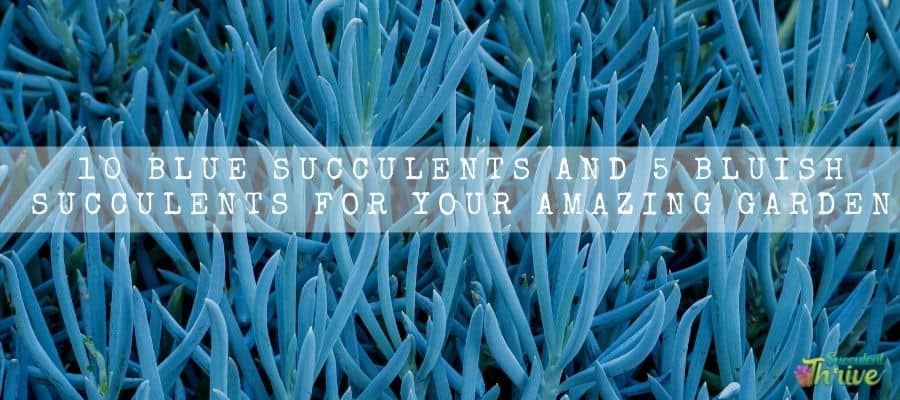
Blue succulents
Senecio Mandraliscae (Blue Chalk sticks)
Blue chalk sticks are endemic plants to South Africa. USDA hardiness zones 9-11 are their preferred growing zones.
You could expect the matured blue chalk sticks to rise to 3 feet in height. On the other hand, their width also would be around 2-3 feet.
Blue chalk sticks plant leaves are narrow and long. They resemble plump beans in shape. Those leaves could be bright blue in color. Blue chalk sticks’ leaves length would be about 18 inches.
You could spot them being covered with farina powdery coating too. Further you may grow them as ground covers outdoors as well.
In addition to that you could consider growing them in rockeries too. Literally, you could place them indoors as well as outdoors. They could bloom with small white flowers during mid-summer.
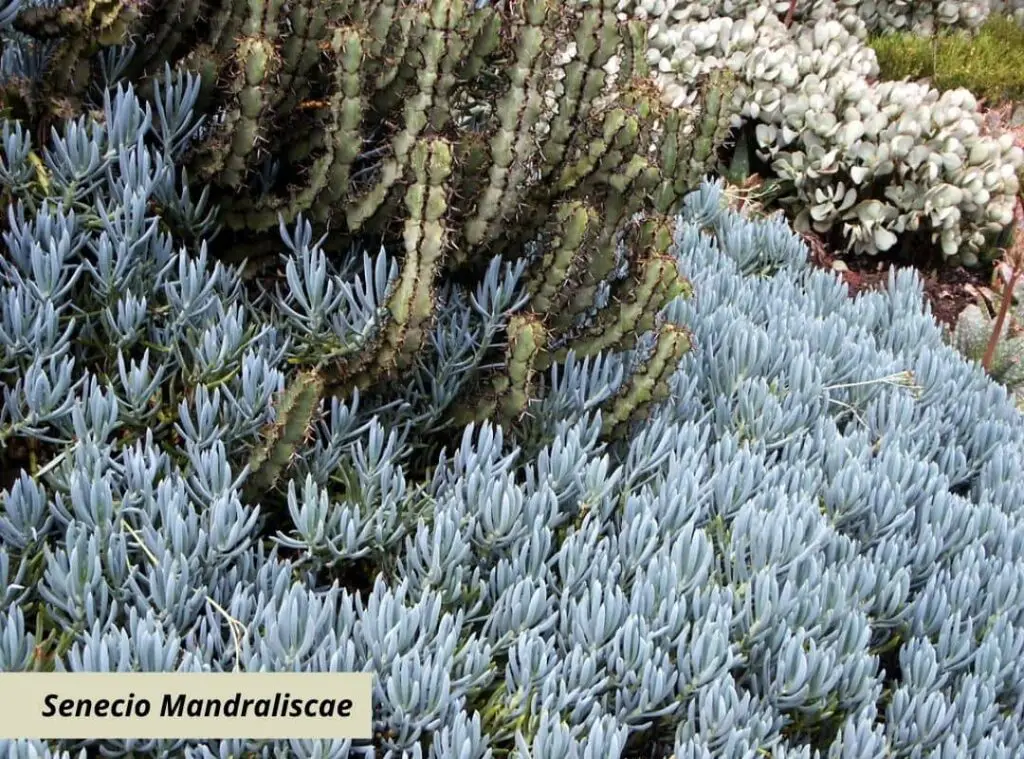
Pilosocereus azureus (Blue Torch Cactus)
Pilosocereus azureus (Blue Torch Cactus) is an attractive columnar cactus plant which could come up with large white flowers along with silvery blue foliage.
These plants would prefer to grow upright. They would further consist of golden or orange spines. Moreover, Blue torch cactus would prefer to grow in USDA hardiness zone 10.
Blue Torch cacti are native plants in Brazil and tend to look more like a tree. They are renowned as a fast-growing set of plants.
You could grow them as indoor plants as well as outdoor plants given that you provide the right growing conditions for them.
However, it is better to arrange a spacious place when you are growing them indoors. They could usually rise to 33 feet in height when grown outdoors.
When you are growing them indoors and if you feel like they are getting bigger, you could consider shifting them outdoors and growing baby plants instead.
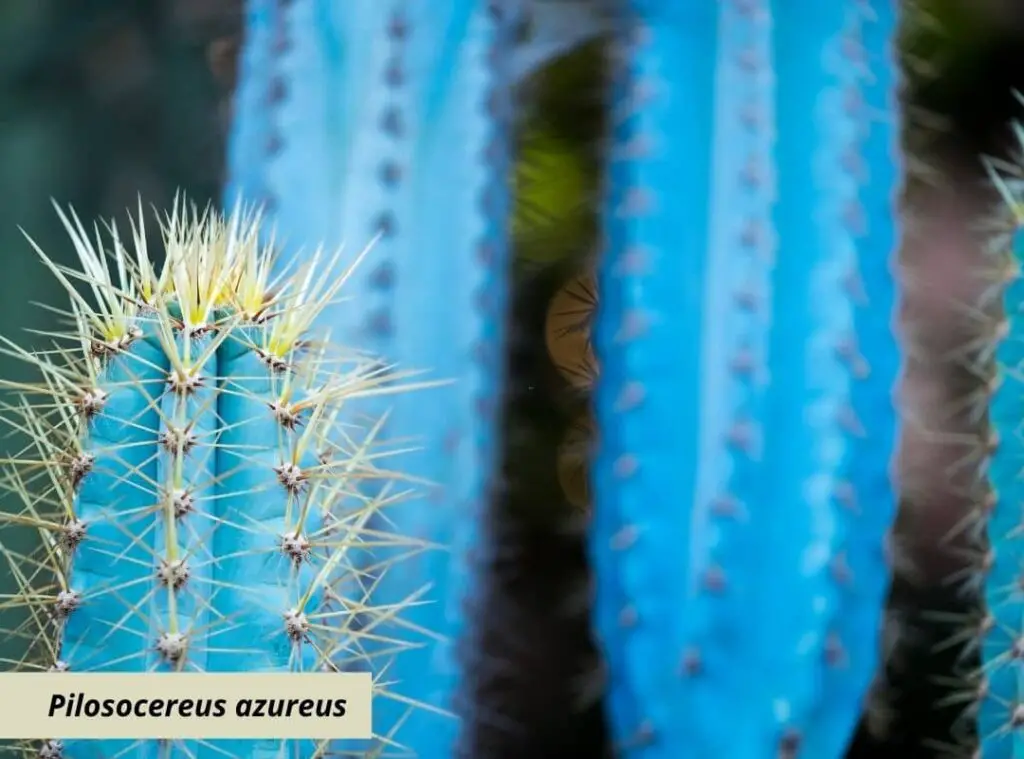
Corpuscularia Lehmannii (Ice plant)
Corpuscularia Lehmannii tend to grow compactly, yet they will grow faster. Ice plant is the common name of these plants.
Best is to grow them indoors. However, you need to expose them to bright sunlight so that they can grow well.
Consequently it would help to intensify the leaves’ color as well. They are suitable for growing outdoors as well.
However, you should protect them from colder weather conditions. They would be useful as perfect ground covers if you are someone who lives in their recommended hardiness zone.
They consist of chubby leaves which you could spot in blue green. They tend to look like ice cubes and grow in opposite pairs.
Apart from that, these plants will have a three-sided triangular look as well. in terms of the sizes of these plants, they would be about 4-6 inches in height and 1-2 feet in width.
USDA zones 9a-11 are the perfectly fitting zones to grow these plants. Further These plants would produce yellow flowers during summer. Ice plants are endemic plants to South Africa.

Echeveria ‘Blue Bird’
Echeveria Blue bird plants have a vibrant deep blue gray color foliage. Further their leaves could be spotted with fuchsia tips.
They tend to form in rosette types. Those leaves would be thick and silvery blue in color. These bluebird plants consist of a farina layer which will give a velvety look to the plant.
Further, their leaves would consist of a powdery coating as well. The blue bird rosette would be about 10 inches (25cm) wide.
Blue bird rosettes could even look like flowers. These plants would form in clumps. Further, their offsets could also grow in the same pot.
They are suitable for indoor growing as well as for outdoor growing . However, ensure that you expose them to bright sunlight when you are growing them indoors.
Further, when you grow them outdoors, protect them from frost conditions. Blue bird plants preferred by USDA zones are 9b-11b.
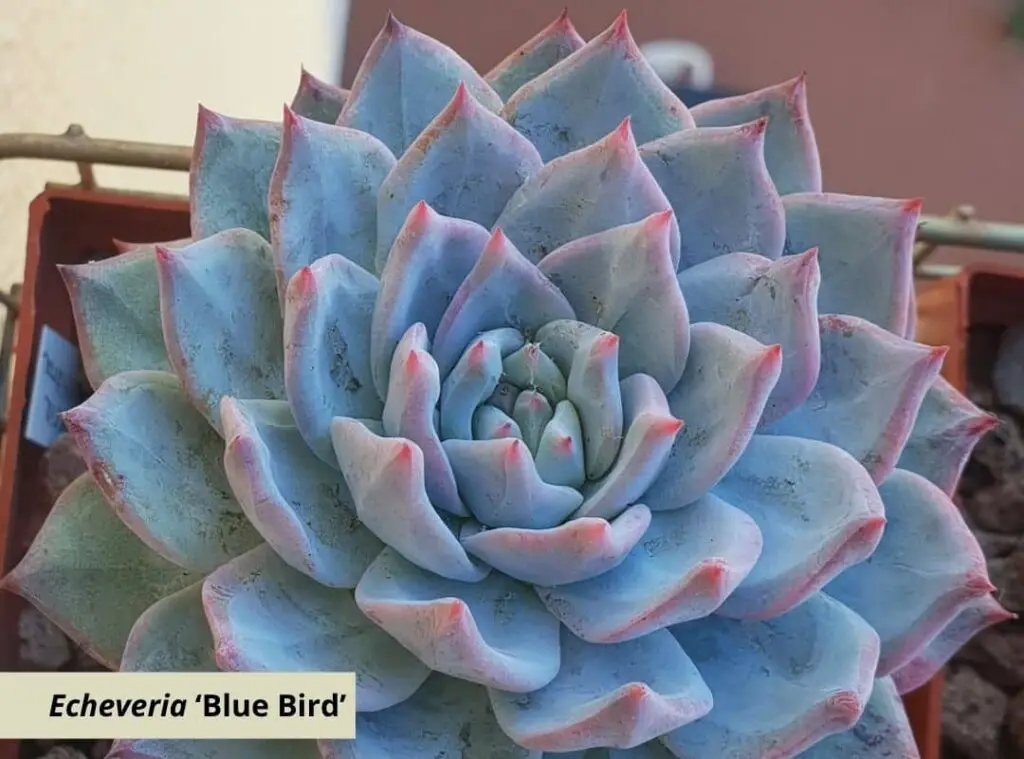
Stonecrop ‘Blue Spruce’
Stonecrop – blue spruce plants are perennial plants which comprise leaves which have a resemblance of fir tree or rosemary leaves.
They would be useful as trailing plants too. They will bloom with yellow star shaped flowers during summer.
Blue Spruce preferred USDA hardiness zones are 4-9. These plants usually form blue green colored leaves which tend to appear as needles. Those leaves will grow around the lax stems.
They could be grown as outdoor ground covers. Having said that You could grow them indoors as potted plants too.
Alternatively, you could grow them in a larger pot along with a taller succulent. As such they would be useful for succulent arrangements.
These plants are native in South America and in North America. They would be 6-8 inches in height and 12-24 inches in width.
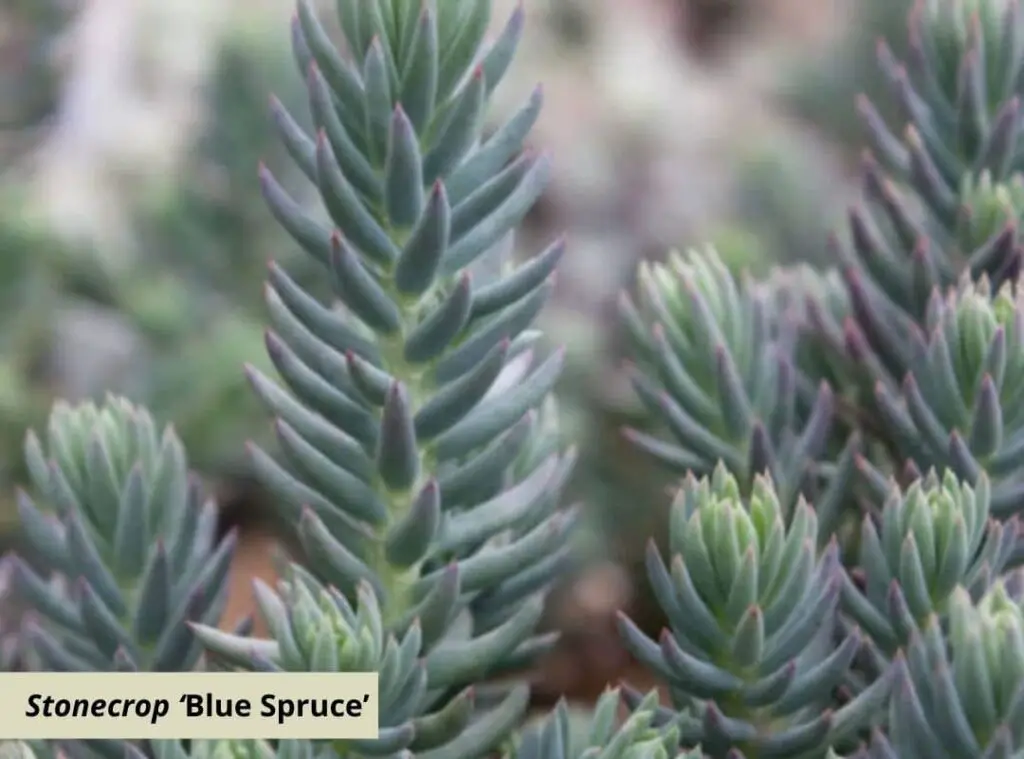
Echeveria ‘Blue Waves’
Echeveria blue waves generally form with leaves which tend to look like a cabbage. They would be green-blue in color along with leaf tips and purple.
Leaves form in a Rosset shape and they would be about 30 cm wide. Blue wave leaves would be crinkly and wavy too.
Chances are that you could spot them in mint green to lavender gray color too. In terms of flowering, they would make red or orange blooms in summer.
Blue waves are native plants in Mexico. You could grow them indoors as well as outdoors given that they get all their right growing conditions.
You may use them for succulents’ arrangements as well. Their preferred USDA hardiness zone is 9b-11b.
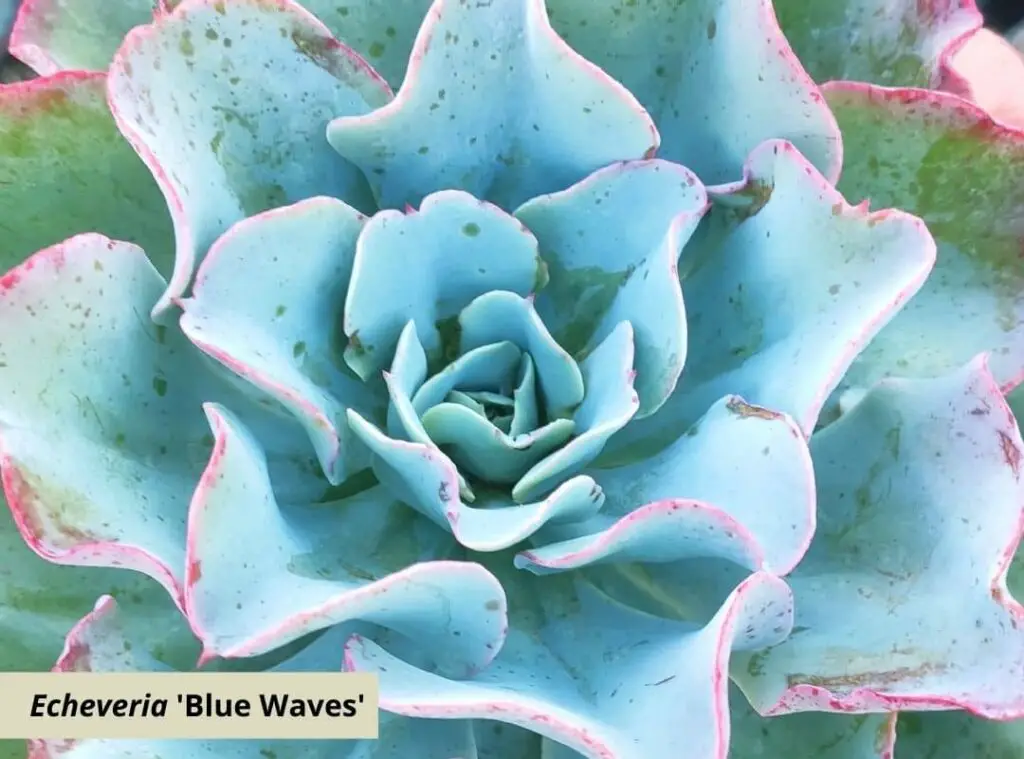
Ferocactus Glaucescens
Blue barrel cactus could be grown in outdoor pots or in indoor gardens as well. You could usually spot them as fat round shaped cactus types in a deep green blue color.
In addition to that, they will consist of spikes in yellow. Further blue barrel cacti will produce flowers in yellow as well.
You could spot them growing in clumps or as solitary plants. These are endemic plants to Mexico. They would be about 1-2 inches in size once they are fully matured.
Their preferred hardiness zones are USDA 9-11 zones. They are so pretty to watch since they would tend to look like living sculptures once you grow them in mounds.
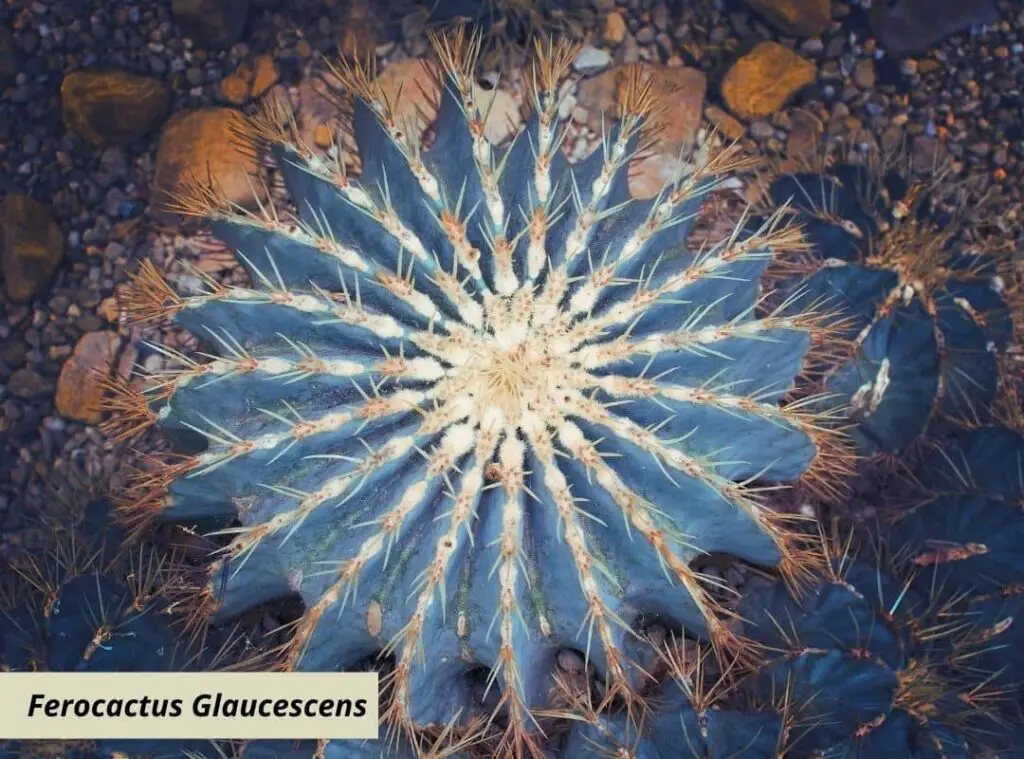
Pachyveri ‘Jeweled Crown’
Jeweled Crown plants could be about 15 cm in height once they grow to their fullest potential. They have also got very unique fat leaves which form in Rosset shape.
They will initially form a tight Rosset which would become loose as they mature. Blue-green are the colors of them which would later turn into blush pink in the leaf’s margins.
You could expect them to flower with yellow or orange star shaped blooms in summer. These plants would grow up to 60 cm (5 feet) in height.
They are great picks for both indoor gardening and for outdoor gardening. They are tolerant of high temperatures, and you could keep them outdoors even during summer.
They would prefer to grow in USDA hardiness zones 9a-11b. These are endemic plants in Mexico.

Graptopetalum Pachyphyllum Bluebean
Blue bean plants are low growing succulents. You could spot them branching around the base of the plant. further they will consist of sprawling stems and leaves in blue green colors.
Those leaves will further consist of red margins. Moreover, their leaves would form in low growing clusters of the Rosset type.
In terms of the sizes of the plant, they would be about 8 inches in height. Further, they would prefer to grow in USDA hardiness zones 9b-11b.
You could grow them indoors or outdoors as you wish. These plants are native plants in mountains in central Mexico. They are special since they carry a light fragrance as well.
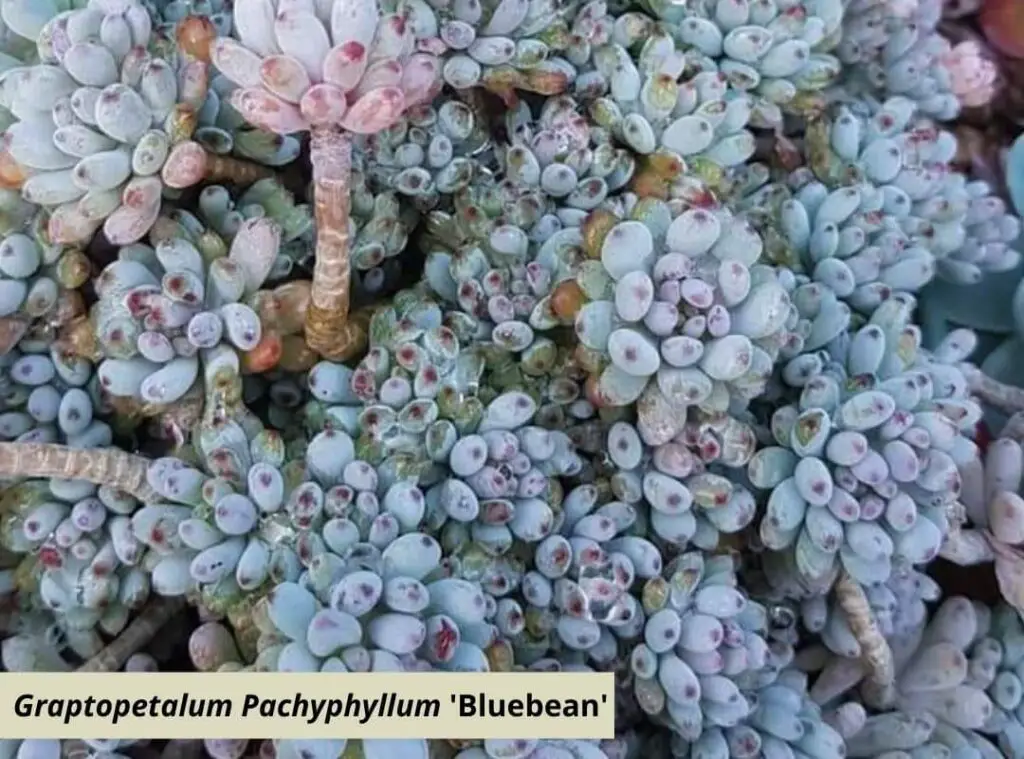
Myrtillocactus Geometrizans (Blue Candle Cactus)
Blue candle cactus are native plants in Mexico. They also grow in blue-green colors, and this could be considered as a columnar succulent.
They would usually grow up to 13’ to 16’ feet in height. Blue candle cactus also has a light fragrance. They could be quite handy for both indoor gardening and for outdoor gardening as well.
If we elaborate further on their stems, they will have a thickness of 2’-4’. Further, their stems would also be blue green or blue gray.
They do not branch for a long time, but once they are matured and older enough, they will tend to form branches. Blue candle cactus would prefer to grow in USDA hardiness zones 9-11.
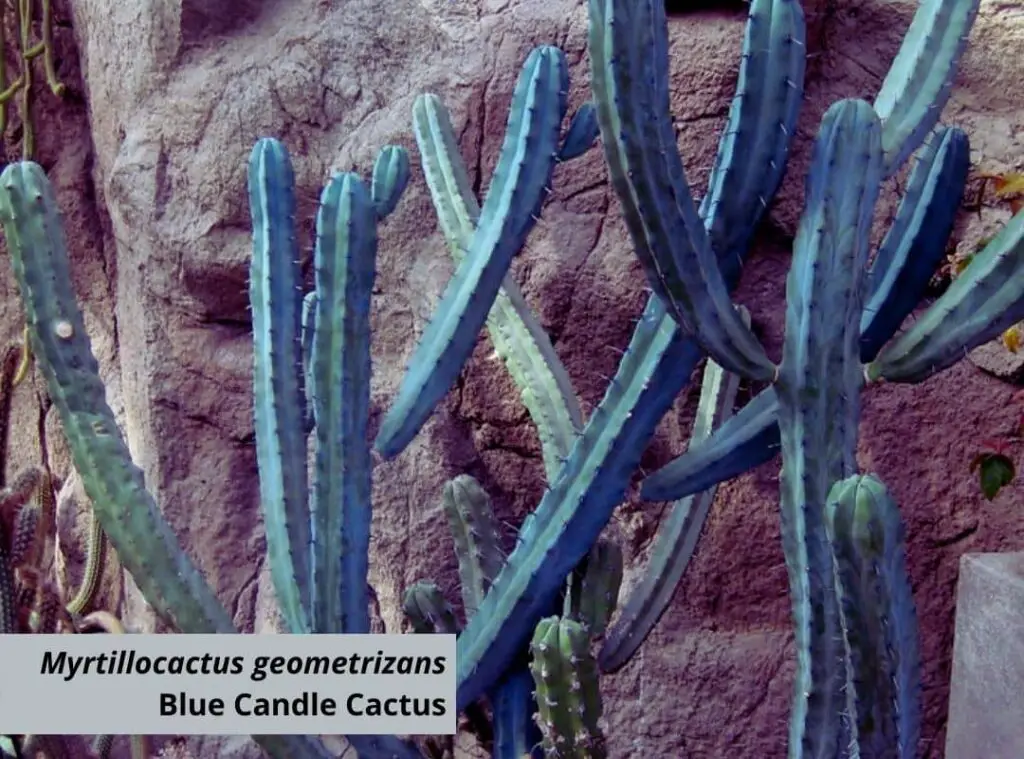
Bluish succulents
Echeveria ‘Blue Prince’
Blue prince plants could be grown both indoors and outdoors. However, it is best to shift them indoors when the weather conditions become much cooler.
They would produce pink to red flowers during summer. Those flowers will form in clusters while on the other hand their leaves will form in Rosset types.
The Rosset would be about six inches in width.
Blue prince leaves would further carry a coating of fine powdery residue as well. Those leaves would be blue-green in color, and they will turn bronze during Autumn when the temperature drops.
They are native plants in Mexico. When you expose them to bright sunlight, they tend to grow compact and their dark blue color will also be intensified.
Their preferred USDA hardiness zones are 9,10,11.
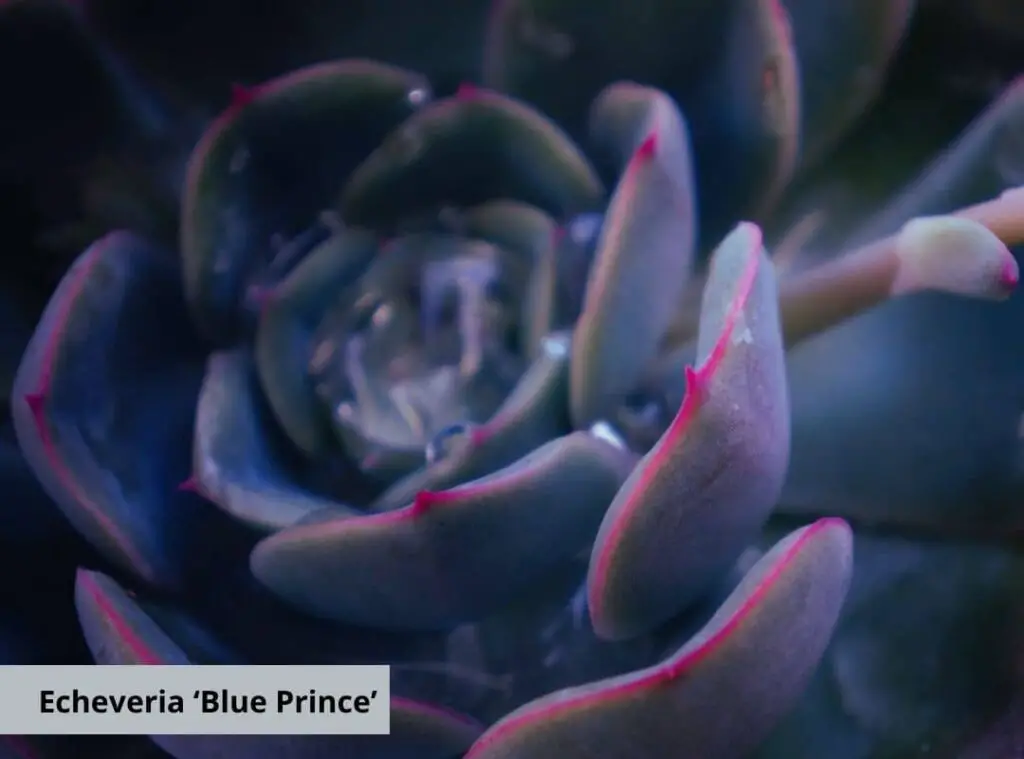
Sedeveria ‘Blue Burrito’
Blue Burrito is a hybrid formation of sedum morganianum and Echeveria peacockii. They would comprise silver-blue green colored pointed leaves along with margins in pink.
Those leaves will form a rosette type. Those rosettes would be six inches wide. On the other hand, their stems will grow up to 12 inches in height.
Blue Burrito plant leaves also consist of a farina layer which provides a powdery look.
You could grow them anywhere be it indoor or outdoor Further, they would prefer to grow in USDA hardiness zones 9,10 and 11.
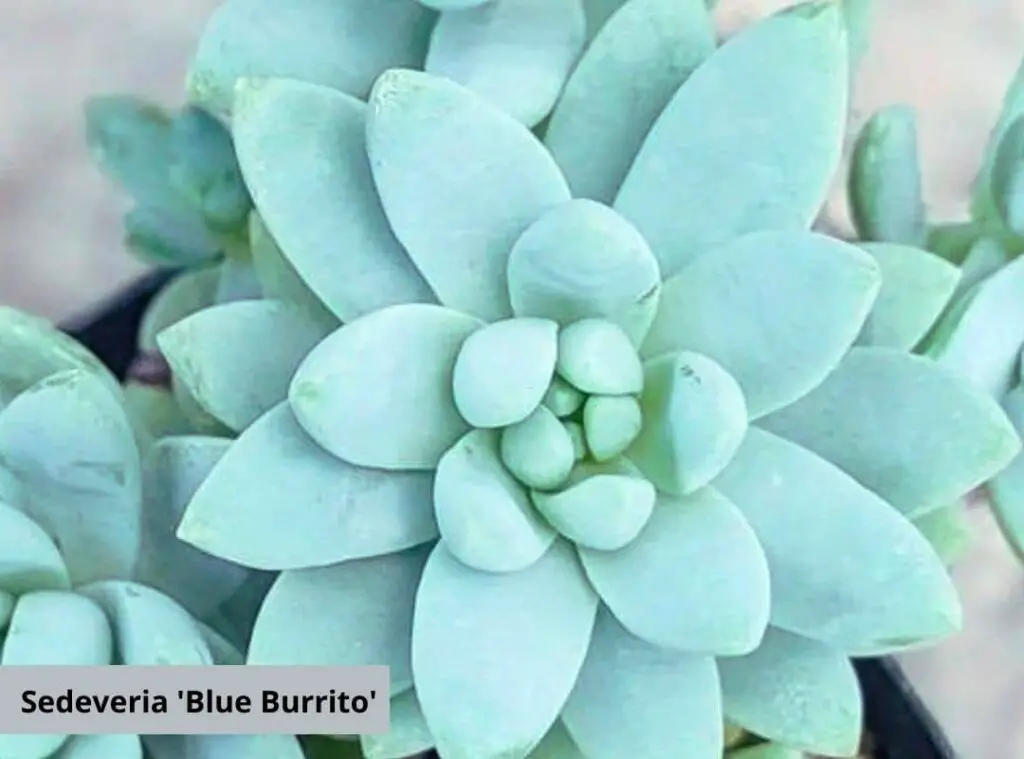
Aloe ‘Blue Sky’
Aloe Blue sky plants would be more suitable for outdoor gardening rather than indoor growing. further they would prefer to grow in USDA hardiness zones 9a-11b.
These are yet another magnificent looking blue succulents which usually form pale blue colored leaves along with spikes made in orange.
Aloe Blue leaves also form in rosette types. When you expose them to bright sunlight, their colors intensify.
You could expect them to flower with orange blooms during spring and in summer. These plants are a hybrid formation of Aloe sinkatana and Aloe suprafoliata.
Aloe blue sky resembles a beautiful scene of sunrise.
Aloe ‘Blue Elf’
Aloe Blue Elf is one of the tallest aloes as they can rise 45 cm when they are fully matured. They are in fact a horticultural hybrid too.
Blue Elf leaves are long and slender. Further they would curve upward and form in a rosette manner. You could spot them in deep green blue.
Further those leaves consist of orange spikes as well. You could expect them to flower in late winter and in early spring along with red or orange blooms.
You could grow them indoors as well as outdoors. They would prefer to grow in USDA hardiness zones 9z-11b. These are endemic plants to South Africa
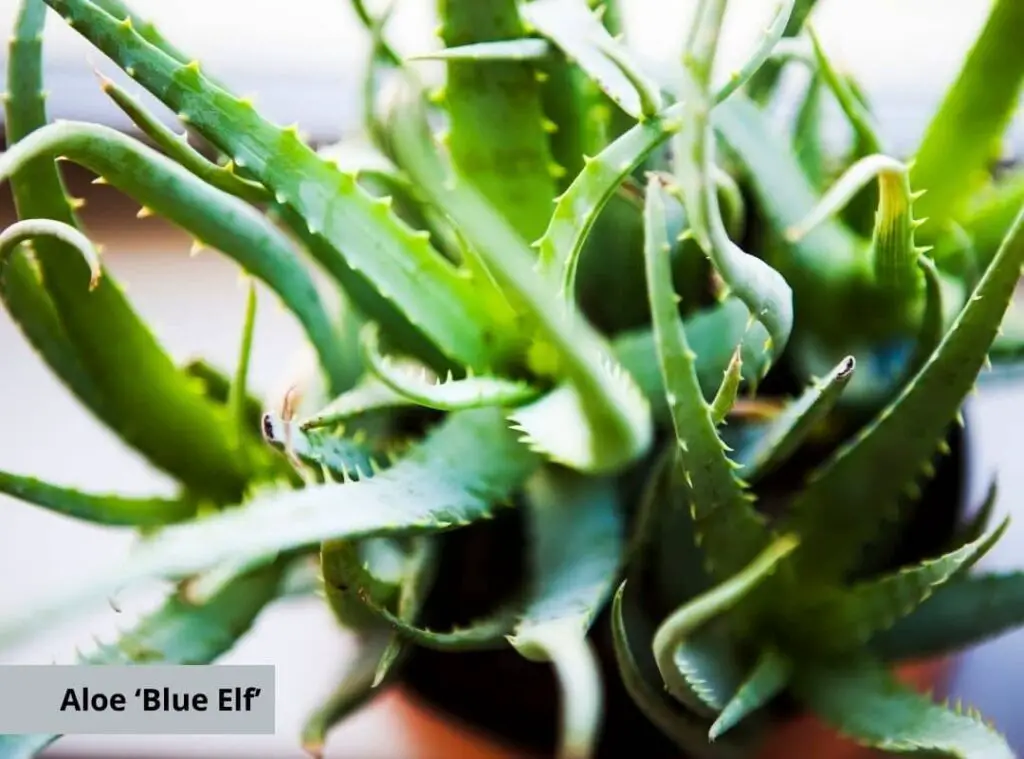
Agave Butterfly
Agave butterfly plants are another stunning type of blue succulents. You could spot them growing in chrysanthemum shape.
Agave butterfly leaves would be large and light blue green in color. They would rise to 60 cm in height. Further they could be about 90 cm in width too.
They would produce flowers which are small and yellow-green in color. Agave butterfly plants would also form rosettes which are symmetrical.
Agave butterfly plants are endemic plants to Mexico. They would prefer to grow in USDA hardiness zones 9b-10.
You could grow Agave butterfly plants indoors as well as outdoors. However, you need to make sure that you fulfill all their basic growing conditions.
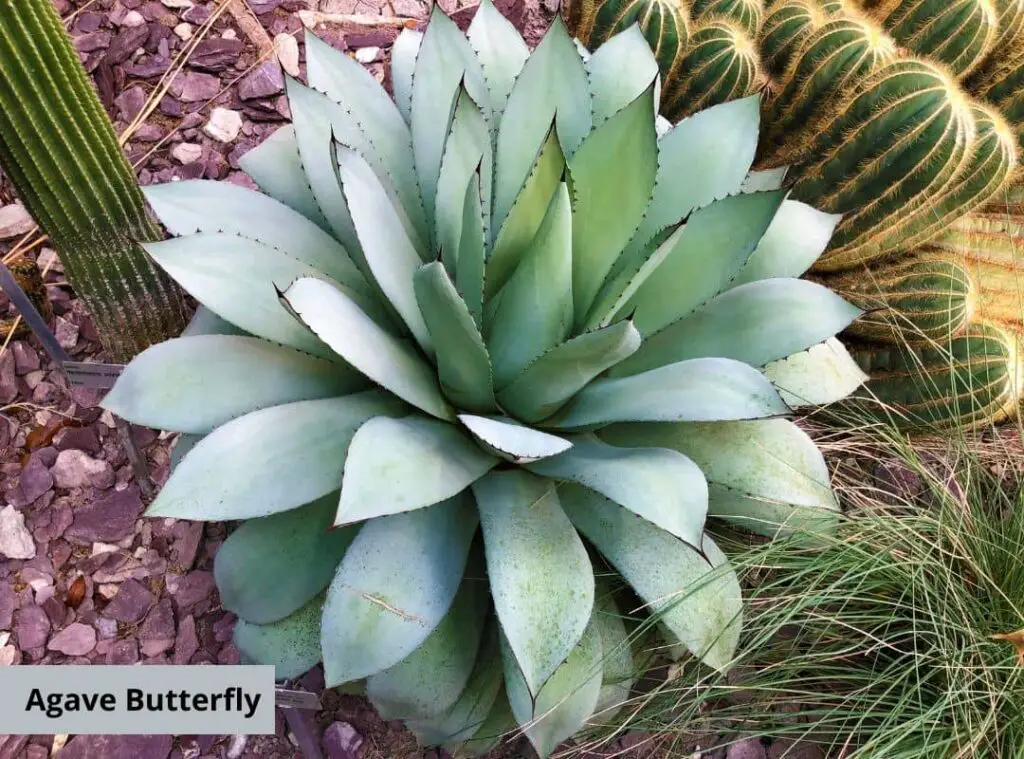
Related questions
Are there any blue succulents?
There are blue succulents. The best of the blue succulents is Agave tequilana Blue Agave. They are native plants in Mexico.
Agave tequilana Blue Agave would produce leaves which are about four feet in length. They tend to look like long lace in shape. Those leaves form a Rosette type.
You could spot succulents in different shapes, sizes and in different colors. However blue succulents are the highlight of all these succulents. You could use them for dish gardens, outdoor gardens and so on.
How do I make my succulents blue?
You need to make sure that they are exposed to bright sunlight so that they can enhance their vibrant blue color.
If you do not expose them to low light levels, it is very unlikely that you will succeed in making the succulents blue.
Are Blue Pearl chlorophytum real?
They are not real since they do not exist.
Are Rainbow succulents real?
Rainbow succulents do exist and they are real. They are a set of colorful succulents which form fleshy leaves in an overlapping manner.
Further they form in the Rosset type. When the season changes take place, their colors will also change. Rainbow succulents would produce rosettes which are 6 inches in height.
Rainbow succulent leaves will carry leaf tips in pink too. When you expose them to low light, you could spot them in gray, red.
As time passes, those colors will become darker. What is important is to take care of them well just like you do with the other ordinary succulents.
Conclusion
So, I hope this article was helpful for you to decide on the exact blue succulents you would wish to have. You can always grow green succulents as they would be lovely to have too.
However as aforesaid, if you would love to add a little touch of blue, you could consider adding blue succulents.
I am sure they will become your favorites once they grow to their fullest and grace the entire set up you have grown them. Happy gardening !
Read Next : White succulent | 15 Unique White Succulents For Your Garden |
Read Next : Black succulents | 13 Unique Black Beauties For Your Garden |
Read Next : Yellow Succulents | 9 Unique Yellow Succulents For Your Garden |
